|
 Hygrocybe cerinolutea Hygrocybe cerinolutea
BiostatusPresent in region - Indigenous. Endemic
Images (click to enlarge)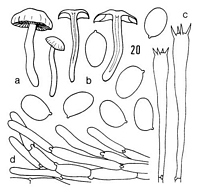
Caption: Hygrocybe cerinolutea Hk. (type): a. carpophores. - b. spores. - c. basidia. - d. cuticle | 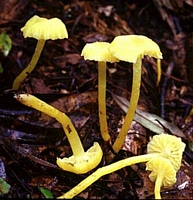
Caption: Hygrocybe cerinolutea
Owner: Kaimai Bush | 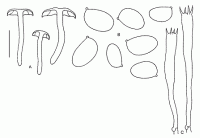
Caption: Fig. 2 Hygrocybe cerinolutea Horak (A-C: PDD 27083, type): A.
basidiomeB. spores. C. basidia. | 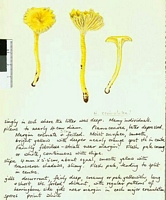
Caption: Watercolour
Owner: G.M. Taylor | 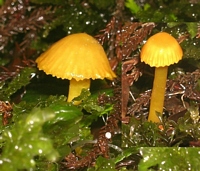
Caption: FUNNZ photo
Owner: J.A. Cooper | 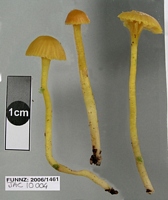
Caption: FUNNZ photo
Owner: J.A. Cooper | 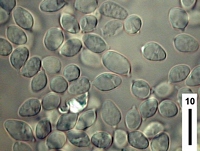
Caption: spores
Owner: J.A. Cooper | 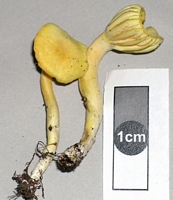
Owner: J.A. Cooper | 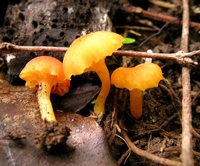
Owner: J.A. Cooper | 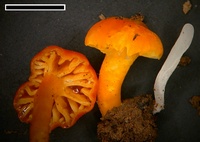
Caption: scale=5mm
Owner: J.A. Cooper | 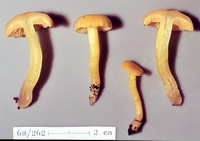
Caption: ZT68-262 , Holotype
Owner: E. Horak: © Creative Commons Attribution-Noncommercial 3.0 New Zealand | 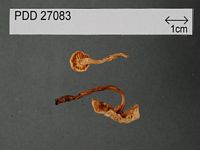
Caption: Dried type specimen
Owner: Herb PDD | 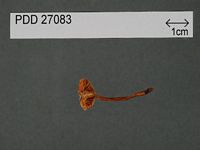
Caption: Dried type specimen
Owner: Herb PDD |
Article: Horak, E. (1990). Monograph of the New Zealand Hygrophoraceae (Agaricales). New Zealand Journal of Botany 28(3): 255-306 (http://www.rsnz.org/publish/abstracts.php).
Description: Pileus -25 mm, hemispherical becoming convex to expanded, flat or subdepressed
at centre; golden yellow to lemon yellow; dry, minutely felty to subsquamulose,
hygrophanous, margin non-striate. - Lamellae 10-14 (1 -3) broadly adnate to
decurrent (with short tooth); concolorous with pileus, edges yellow, entire.
–Stipe 25-40 x 3-5mm, cylindrical, equal or slightly attenuated towards base;
concolorous with pileus, yellowish-grey near base; dry, glabrous, hollow to
stuffed, single or caespitose. - Context yellow, not blackening, waxy. - Odour
and taste not distinctive. - Chemical reactions on pileus: KOH, HCl, NH3
- negative.
Spores 8-10 x 5.5-7 um (-13 x -8 um on 2-spored basidia), ovoid. – Basidia
65-80 x 8-10 um, 4-(and 2-) spored. - Cystidia absent. - Pileipellis a cutis
or trichoderm of cylindrical appressed or suberect hyphae (5-10 um diam.), membrane
not gelatinised, with plasmatic pigment; clamp connections present (Pl. 1, Fig.
1).
Habitat: ECOLOGY: Rare, saprobic on soil among litter in broadleaved forest (dominated
by Metrosideros, Weinmannia, Quintinia). April.
Distribution: DISTRIBUTION: NZ (WL).
Article: Horak, E. (1973). Fungi Agaricini Novazelandiae I-V. Beihefte zur Nova Hedwigia 43: 200 p.
Description: Pileus 10-25 mm diam., hemispherical when young becoming convex then expanded, flat at the centre, golden yellow to lemon yellow, hygrophanous, estriate, dry, minutely squamulose to felty. Lamellae broadly adnate to decurrent with short tooth, coloured like pileus or deep yellow, without red or orange tinge, gill edge concolorous, even. Stipe 25-40 x 3-5 mm, cylindric, equal or slightly attenuated towards the base, concolorous with pileus, yellowish-grey near the base, dry, glabrous, waxy, hollow or stuffed. Context yellow, not blackening. Taste and odor not distinctive. Chemical reaction on pileus: KOH, NH3 and HCl - negative.
Spores 8.5-10 x 6 µm (11-13 x 6.5-8 µm borne on 2-spored basidia), ovoid, smooth inamyloid. Basidia 65-80 x 8-10 µm, 4 and 2-spored. Cystidia absent. Cuticle trichodermium consisting of suberect, cylindric, not gelatinized hyphae (5-10 µm diam.), plasmatic pigment present. Clamp connections numerous.
Habitat: In soil under Metrosideros umbellata, Weinmannia, Quintinia, etc. New Zealand.
Notes: Macroscopically this species is near H. ceracea (Fr.) but the spores of the N.Z. fungus are considerably larger and there is no gelatinous layer on the pileus and stipe.
|